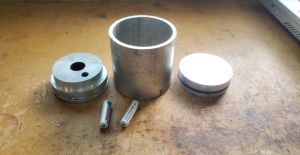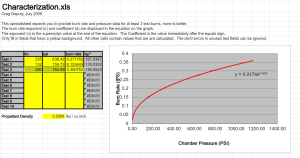Propellant Characterization: Difference between revisions
No edit summary |
No edit summary |
||
| Line 5: | Line 5: | ||
[[File:4" end burning test motor.jpg|thumb|alt=Characterization test motor, end burning config.|Characterization test motor, end burning config. Note the ports in the top bulkhead for interchangeable nozzles and a pressure transducer.]] | [[File:4" end burning test motor.jpg|thumb|alt=Characterization test motor, end burning config.|Characterization test motor, end burning config. Note the ports in the top bulkhead for interchangeable nozzles and a pressure transducer.]] | ||
[[ | [[Index.php?title=Characterization Motor|Characterization_Motor]] | ||
You can also use a simple bates grain motor that is designed to keep the [[Kn]] as constant as possible, a strand burner, or other techniques. What is important is to get as accurate as possible data points. | You can also use a simple bates grain motor that is designed to keep the [[Kn]] as constant as possible, a strand burner, or other techniques. What is important is to get as accurate as possible data points. | ||
[[File:CharacterizationGraph.png|alt=Example output of the propellant characterization spreadsheet|left|thumb|Example output of the propellant characterization spreadsheet]] | [[File:CharacterizationGraph.png|alt=Example output of the propellant characterization spreadsheet|left|thumb|Example output of the propellant characterization spreadsheet]] | ||
Once you have those data points there are several options for getting your Burn Rate Exponent and Coefficent. I use a [http://www.blastzone.org/characterization/characterization.xls spreadsheet in Microsoft Excel]. The spreadsheet uses some advanced features in Excel to match the data points to a curve and provided the necessary values. Some versions of [[ProPep]] will also do this data crunching for you. | Once you have those data points there are several options for getting your Burn Rate Exponent and Coefficent. I use a [http://www.blastzone.org/characterization/characterization.xls spreadsheet in Microsoft Excel]. The spreadsheet uses some advanced features in Excel to match the data points to a curve and provided the necessary values. Some versions of [[ProPep]] will also do this data crunching for you. | ||
Revision as of 18:45, 14 November 2022
In order to simulate a motor in BurnSim you need your propellant's characterization numbers. This consists of 4 things. Propellant density, C* / ISP*, Burn Rate Exponent (n) and Burn Rate Coefficient (a). Propellant density and C* / ISP* can be determined through ProPep software.
To get the burn rate exponent (n) and burn rate coefficient (a) you need test data. Specifically, several burn rate / pressure data points. IE, at what rate does the propellant burn at various chamber pressures. A minimum of 3 data points must be used, more is better. The test data can be acquired through the use of a test motor. The design I use is a simple motor that uses 4" diameter end burning grains with interchangeable nozzles and a pressure transducer.
You can also use a simple bates grain motor that is designed to keep the Kn as constant as possible, a strand burner, or other techniques. What is important is to get as accurate as possible data points.
Once you have those data points there are several options for getting your Burn Rate Exponent and Coefficent. I use a spreadsheet in Microsoft Excel. The spreadsheet uses some advanced features in Excel to match the data points to a curve and provided the necessary values. Some versions of ProPep will also do this data crunching for you.

